|
< Earlier Kibitzing · PAGE 3 OF 3 ·
Later Kibitzing> |
| Aug-06-08 | | TheaN: <I wonder about 27...Qxc5 in your line.> <28.Ne8...>
Ironic. Only debatable whether this is 1) improving 27.Ne8, 2) if I would've seen Ne8 this time and 3) if there is no better alternative for Black (or White, for that matter). I'm not doubting point one, Ne8 is untouchable now, so Black must defend g7 and White will win at least the full Rook back and destroy Black's position after his g6, so it is better. Point two is not really the point: obvious move but only play would've told it. I was fearing point three in view of <27....Qd8>, but it seems that this just overworks the Queen, as 28.Ne8 is still possible, due to the same threats and Qxe8 is still Qxc7 with the threat of Qxb8, but this is not really different compared to 27.Ne8. |
|
| Aug-06-08 | | DarthStapler: It took me a while but I got it |
|
| Aug-06-08 | | MarkThornton: I once lost to a similar tactic, about 25 years ago. My opponent was very pleased to play "Ne8 1-0", and showed the finish to anyone who would listen to him. I was quite embarrassed! Now I know that this tactic has a distinguished pedigree, I feel a bit better! |
|
| Aug-06-08 | | guybrush: 28. Ne8. What a move! Didn't see that one. |
|
Aug-06-08
 | | Domdaniel: A nice point is that the black Queen is horribly placed after 27.Ne8 Qxe8, a fact that helps White to end the game quickly. It's as important as winning the exchange. |
|
| Aug-06-08 | | A.G. Argent: <DaveZ, Once, soren..."cute"> Hrrumph. |
|
| Aug-06-08 | | YouRang: Not too hard. I saw the key components pretty quickly: - Our Q attacking the black rook
- Black's Q is the sole guard of the black rook (so it is subject to deflection tactics) - The g7 pawn is pinned (if we move our knight).
These ingredients all suggest 26.Nf6+!, since the knight can't be taken by the g7 pawn (it's pinned) nor the queen (without losing the rook). Hence, we must expect 26...Kh8. Here is where I spent more time thinking about it than I should have. I couldn't make captures of the h7 pawn work, nor would attacking g7 via Nh7 work. But I did finally consider attacking g7 from the other angle: 27.Ne8!, creating a tactical fork (lose full rook or get mated), forcing the queen deflection: 27...Qxe8, thus allowing 28.Qxc7, winning the exchange. |
|
Aug-06-08
 | | Domdaniel: Botvinnik was aged just 17 when he played this beauty - almost 20 years before he became world champion, and he was still creating brilliancies in the late 1960s. |
|
| Aug-06-08 | | kevin86: The theme here is that black's queen is overworked;she is forced to guard the rook and f6 square as well. I missed this one by a mile! I was looking at Nh6+ instead,but I don't see a second punch after Kh8 |
|
| Aug-06-08 | | lost in space: Hi <TheaN:>,
I found 27. Bh7 not so strong due to the following line: 26. Nf6+ Kh8 27. Bxh7 Bb7 28. Nh5 (do you see a better one) f6 29. Bd3 Qxc5 |
|
| Aug-06-08 | | lost in space: Hi <TheaN>,
I was in a hury during my last post, so now with more time. The key issue with 27. Bxh7 is that Black get time to take controle of the important square d5, not allowing Nd5. After 27...Bb7 I don't see a real good move for white. 28. Nh5 is threating mate and keeping a white advantage. 27...f6 Black is threating to take the Bh7. Now white can play 28. Bd3 or 28. Bf5. Both is answered with Qxc5 with advantage white, but I don't think that the position can be called "won for white". A small remark: 28. Bf5 e5?! Nf4 and Black is in trouble. This is what I meant with 27. Ne8 is stronger than 27. Bxh7 |
|
| Aug-06-08 | | 456: Tuesday puzzle Aug-05-08 <9. ?> Motylev vs A Czebe, 2008 |
|
| Aug-06-08 | | TheaN: <lost in space>
Seems like you're right. As I've analysed with Qxc5 and Qd8, 27.Ne8 is at least a lot faster, but 27....Bb7 indeed seems to hold White of, Black seemingly worse, those. No point for me it seems; thanks for the confirmation. |
|
| Aug-06-08 | | Kasputin: White has lots of action around black's king but what specifically should white do? Candidates:
26. Bxh7+
It looks like black has this covered (the f8 knight protects h7) but it does allow white to bring the e1 rook up the board. 26. Nh6+
The knight is immune from capture but then what?
26. Nf6+
Black's c7 rook is protected by the queen, but if black takes this knight, then the c7 rook can be captured. 26. A queen move - e.g., to h3, d3, etc... This kind of thing looks slow (why reposition the queen?) - also it allows the c7 rook to move (e.g. to capture white's c-pawn) because it voluntarily breaks the pin on the rooks 26. A rook move - I don't see any immediate benefits but this could could be looked at if necessary. ----
26. Nf6+
And black is faced with a) moving the king to h8 or b) playing ...Qxf6 a)
26 ...Kh6
27. Ne8 threatening mate
27 ...Qxe8 is essentially forced or else black goes down an entire rook
28. Qxc7
It looks bad for black. Black is down more than just the exchange. All black's pieces are on the back rank. White has a nice centralized bishop (which incidently prevents black from playing ...Ra8 or ...Rb7). Plus white has a passed pawn and threatens black's a-pawn as well. b)
26 ...Qxf6
27. Qxc7
And really the position is similiar to a) above. Except here black's c8 bishop is in trouble if the b8 rook moves away. The other thing that might be worth pointing out is if black allows white to capture the c7 rook without capturing the white knight (e.g., after 26. Nf6 Kh1; 27. Ne8 Ng6), then white may be better off taking the rook with the queen instead of the knight. But that could be looked at more closely if black actually allowed the straight rook capture rather than the exchange trade. |
|
| Aug-06-08 | | Duck McCluck: Does anyone else get that google-ad about $4 gas? Is it because of my firefox/google toolbar? Or is it a chessgames ad? It says "ads by google" and google used to only use keywords, and not banners? |
|
| Aug-06-08 | | permutation: 27Nh5 also threatens mate but is not so forcing, as white has the resource of (after g6 or g5)...28Qe5 f6 and white still has work to do. 27Ne8 is the key move, then.
ps it's 12.30pm here and it's too late
to be clever. |
|
| Aug-06-08 | | Woody Wood Pusher: Master Chess (32 bit 20 MHz) sees this one instantly but 27 Ne8 took me a little longer. |
|
| Aug-07-08 | | Gilmoy: <johnlspouge: I had failure of board vision on 28.Bxh7+, which is <not> check ... I note <Gilmoy> had the same lapse.> Oh, I knew it wasn't check -- I wrote it correctly as 28.Bxh7 (see my post). It was a clearance sac, not a demolition sac. |
|
| Aug-07-08 | | Marmot PFL: I would miss this OTB. Only saw it here after looking at every move to deflect the BQ from Rc7. |
|
| Dec-17-09 | | acirce: Glad there are some easy clues so that us cretins have a chance from time to time. |
|
Dec-09-11
 | | Penguincw: 27.♘e8 was a nice deflection move. |
|
| Jul-22-13 | | BlackFront: According to the DB, Botvinnik's only game in 1928, which seems highly improbable. Perhaps some of the drones otherwise busy in the Biographer Bistro could allocate some of their effort to documenting and rectifying, where possible, the gaps in the records of the great players. |
|
| Jul-22-13 | | SimonWebbsTiger: the record is:
1927/8 Metal Workers' Chp. (+7-1=3)
1928 Match of Higher Educational Establishments (+1=1)
1928/29 Trades Union of Education Workers Chp (+8=5)
Source: Botvinnik's Best Games Vol. 1 1925-41, Moravian Chess, 2000. |
|
| Jul-22-13 | | BlackFront: To start the ball rolling, I'll submit Botvinnik's 97 move win over Mikhail Shebarshin from the 1926 Leningrad Championship semi-finals. Who he? <But the name of Shebarshin, a math teacher, disappeared from the chess press after the 1930 Rabpros Championship. He was charged with "attempting to organize a counterrevolutionary mutiny." Shebarshin vanished into a prison camp, where he was known to play chess and even be regarded as camp champion. His ultimate fate is unknown.> (Soltis, Andrew, Soviet Chess 1917-1991, McFarland & Company, 2000) |
|
Jun-11-17
 | | Jimmy720: This is my analysis. All constructive criticism is welcome. I did not use an engine. 1.d4 d5 2.c4 c6 3.Nf3 Nf6 4.e3
the quiet variation
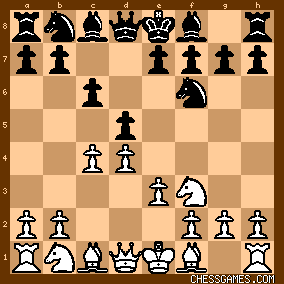
click for larger view 4... e6
a common reply... other good moves are Bg4 and Bf5 5.Nbd2!? Nbd7 6.Bd3 Bd6 7.O-O
O-O 8.e4 dxe4 9.Nxe4 Nxe4 10.Bxe4 Qc7
compare to Capablanca vs C Jaffe, 1910
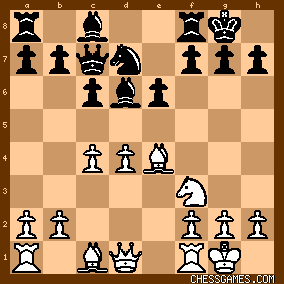
click for larger view 
click for larger view 11.Bc2 Re8
Black is aiming for e5. The pawns breaks c5 and e5 are important freeing moves for Black in this pawn structure. 12.Qd3
A kingside attack is often the result of White's space advantage and active bishops in this structure. Once again, a comparison to Capablanca vs C Jaffe, 1910 is in order.
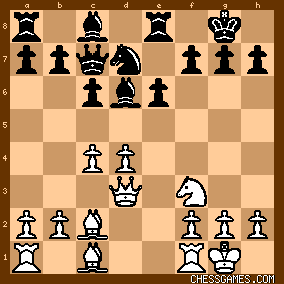
click for larger view 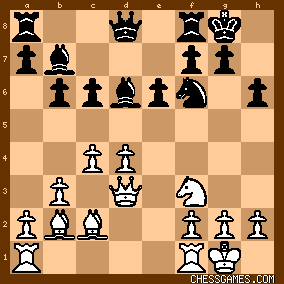
click for larger view 12... Nf8?!
12... Nf6? would fail miserably to 13.Bg4

click for larger view
Nf8 is not strong because the knight remained passive for the rest of the game. The knight was doing an important job, forcing the pawn break e5 through. 12... g6! was stronger. Although this is a scary move to play, it allows Black more activity. Play could then continue 13.Re1 e5 14.dxe5 Nxe5 15.Nxe5 Bxe5 16.h3 Bf5 17.Qb3 Bxc2 18.Qxc2 Rad8

click for larger view
Alhough this is certainly not best play for White, this line shows the activity that comes with 12... g6. 13.Re1 c5 14.dxc5 Bxc5
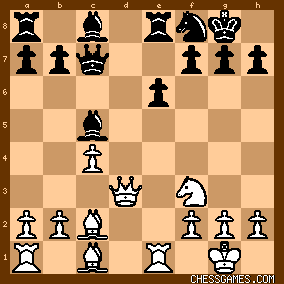
click for larger view
By breaking with c5 instead of e5, Black has given White a <queenside majority>. Botvinnik now plans to advance it to create a passed pawn. 15.a3 b6
One might wonder why Black didn't try to slow down or stop White's plan with 15... a5.

click for larger view 16.b4 Rd8 17.Bf4!
A nice deflection... If 17... Qxf4, then 18.Qxd8 17... Qe7?!
17... Bd6 was stronger. Play could then continue 18.Bxd6 Rxd6 19.Qc3 Bb7 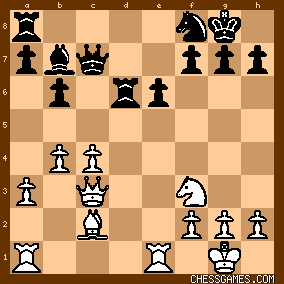
click for larger view 18.Qc3
Bd6 19.Bxd6 Rxd6 20.c5 bxc5 21.bxc5
21... Rd7
losing material by force... 21... Rd8 was better, Black's position is not enviable. 22.Be4 Rb8 23.Ne5 Qf6
24.Qg3 Rc7 25.Ng4 Qe7 26.Nf6+ Kh8 27.Ne8! Qxe8 28.Qxc7 Rb2
29.Rad1 1-0 |
|
 |
 |
|
< Earlier Kibitzing · PAGE 3 OF 3 ·
Later Kibitzing> |





